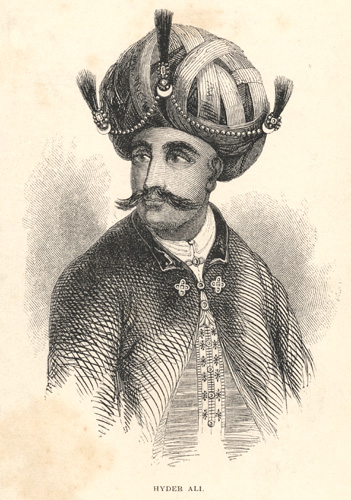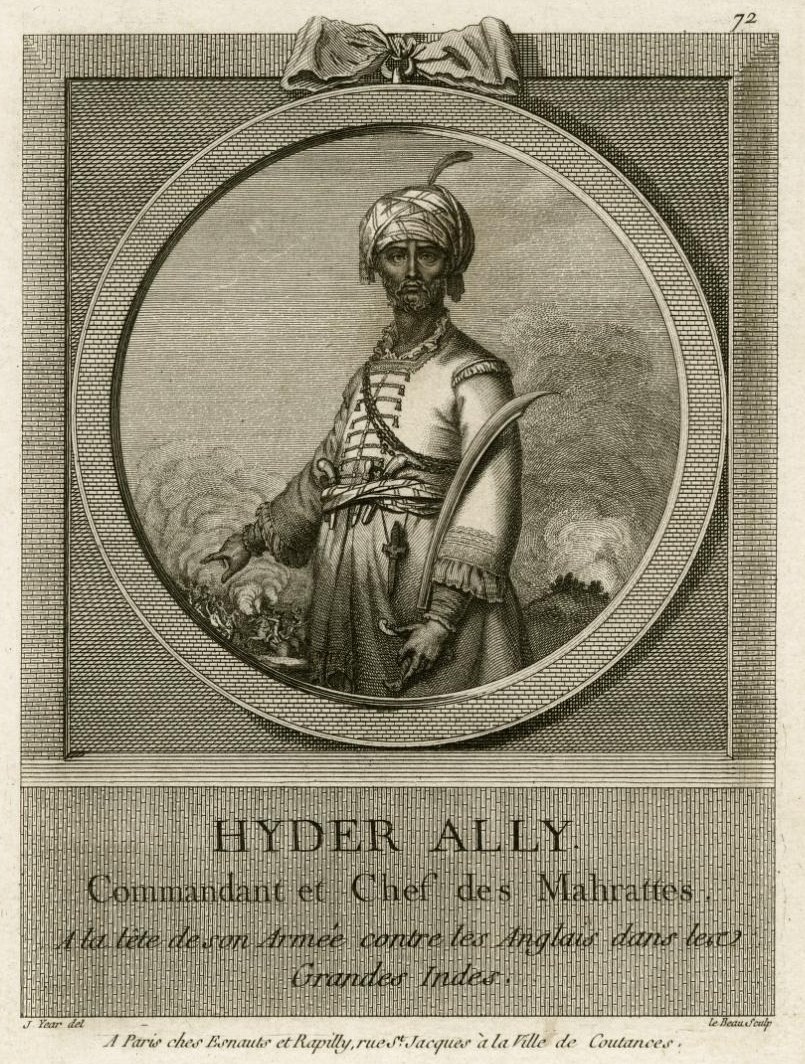|
Battle Of Tiruvannamalai
The Battle of Tiruvannamalai is one of the two successful battles fought by the Madras Army in the Carnatic along with the Battle of Chengam. It was fought on 25 September 1767 between the allied forces led by the East India Company against the troops of Hyder Ali. The allied forces of the English army were led by Colonel Smith. The history of Tiruvannamalai revolves around the Annamalaiyar Temple. The recorded history of the city dates back to the ninth century, as seen from a Chola inscriptions in the temple. After switching hands from various ruling empires like Cholas, Pallavas, Hoysala, Vijayanagar Empire, the town came under the rule of Nawab during the mid of 18th century. Tiruvannamalai was a strategic location between the Northern and Southern Penna rivers. The city was at a strategic crossroads during the Vijayanagara Empire, connecting sacred centers of pilgrimage and military routes. Background The history of Tiruvannamalai revolves around the Annamalaiyar Templ ... [...More Info...] [...Related Items...] OR: [Wikipedia] [Google] [Baidu] |
Anglo-Mysore Wars
The Anglo-Mysore Wars were a series of four wars fought during the last three decades of the 18th century between the Kingdom of Mysore#Under Haider Ali and Tipu Sultan, Sultanate of Mysore on the one hand, and the British East India Company (represented chiefly by the neighbouring Madras Presidency), Maratha Empire, Kingdom of Travancore, and the Hyderabad State, Kingdom of Hyderabad on the other. Hyder Ali and his succeeding son Tipu Sultan, Tipu fought the wars on four fronts: with the British attacking from the west, south and east and the Nizam of Hyderabad, Nizam's forces attacking from the north. The Fourth Anglo-Mysore War, fourth war resulted in the overthrow of the house of Hyder Ali and Tipu (the latter was killed in the fourth war, in 1799), and the dismantlement of Mysore to the benefit of the East India Company, which Company rule in India, took control of much of the Indian subcontinent. The four wars First Anglo-Mysore War The First Anglo-Mysore War (1767 ... [...More Info...] [...Related Items...] OR: [Wikipedia] [Google] [Baidu] |
Nayanars
The Nayanars (or Nayanmars; ta, நாயன்மார், translit=Nāyaṉmār, translit-std=ISO, lit=hounds of Siva, and later 'teachers of Shiva ) were a group of 63 Tamil Hindu saints living during the 6th to 8th centuries CE who were devoted to the Hindu god Shiva. Along with the Alvars, their contemporaries who were devoted to Vishnu, they influenced the Bhakti movement in early medieval South India. The names of the Nayanars were first compiled by Sundarar. The list was expanded by Nambiyandar Nambi during his compilation of material by the poets for the ''Tirumurai'' collection, and would include Sundarar himself and Sundarar's parents. The Nalvar () are the four foremost Nayanars Appar, Sundarar, Sambandar and Manikkavaasagar. History The list of the Nayanars was initially compiled by Sundarar (Sundararmurthi). In his poem ''Tiruthonda Thogai'' he sings, in eleven verses, the names of the Nayanar saints up to Karaikkal Ammaiyar, and refers to himself as "the serv ... [...More Info...] [...Related Items...] OR: [Wikipedia] [Google] [Baidu] |
Mughul Empire
The Mughal Empire was an early-modern empire that controlled much of South Asia between the 16th and 19th centuries. Quote: "Although the first two Timurid emperors and many of their noblemen were recent migrants to the subcontinent, the dynasty and the empire itself became indisputably Indian. The interests and futures of all concerned were in India, not in ancestral homelands in the Middle East or Central Asia. Furthermore, the Mughal empire emerged from the Indian historical experience. It was the end product of a millennium of Muslim conquest, colonization, and state-building in the Indian subcontinent." For some two hundred years, the empire stretched from the outer fringes of the Indus river basin in the west, northern Afghanistan in the northwest, and Kashmir in the north, to the highlands of present-day Assam and Bangladesh in the east, and the uplands of the Deccan Plateau in South India. Quote: "The realm so defined and governed was a vast territory of some , ra ... [...More Info...] [...Related Items...] OR: [Wikipedia] [Google] [Baidu] |
Madurai
Madurai ( , also , ) is a major city in the Indian state of Tamil Nadu. It is the cultural capital of Tamil Nadu and the administrative headquarters of Madurai District. As of the 2011 census, it was the third largest Urban agglomeration in Tamil Nadu after Chennai and Coimbatore and the 44th most populated city in India. Located on the banks of River Vaigai, Madurai has been a major settlement for two millennia and has a documented history of more than 2500 years. It is often referred to as "Thoonga Nagaram", meaning "the city that never sleeps". Madurai is closely associated with the Tamil language. The third Tamil Sangam, a major congregation of Tamil scholars said to have been held in the city. The recorded history of the city goes back to the 3rd century BCE, being mentioned by Megasthenes, the Greek ambassador to the Maurya empire, and Kautilya, a minister of the Mauryan emperor Chandragupta Maurya. Signs of human settlements and Roman trade links dating back to 3 ... [...More Info...] [...Related Items...] OR: [Wikipedia] [Google] [Baidu] |
Krishnadeva Raya
Krishnadevaraya (17 January 1471 – 17 October 1529) was an emperor of the Vijayanagara Empire, also known as the Karnata Empire, reigning from 1509 to 1529. He was the third monarch of the Tuluva dynasty, and is considered to be one of the greatest rulers in Indian history. He ruled the largest empire in India after the decline of the Delhi Sultanate.Keay, John, India: A History, New York: Harper Collins, 2000, p.302 Presiding over the empire at its zenith, he is regarded as an icon by many Indians. Krishnadevaraya earned the titles ''Karnatakaratna Simhasanadeeshwara'' (lit. "Lord of the Jewelled Throne of Karnataka"), ''Yavana Rajya Pratistapanacharya'' (lit. "Establishment of the King to Bahmani Throne"), ''Kannada Rajya Rama Ramana'' (lit. "Lord of the Kannada Empire), ''Andhra Bhoja'' (lit. "Scholar of Andhra"), ''Gaubrahmana Pratipalaka'' (lit. "Protector of Brahmins and Cows") and ''Mooru Rayara Ganda'' (lit. "Lord of Three Kings"). He became the dominant ruler of the ... [...More Info...] [...Related Items...] OR: [Wikipedia] [Google] [Baidu] |
Vijayanagara Empire
The Vijayanagara Empire, also called the Karnata Kingdom, was a Hinduism, Hindu empire based in the region of South India, which consisted the modern states of Karnataka, Andhra Pradesh, Tamil Nadu, Kerala, Goa and some parts of Telangana and Maharashtra. It was established in 1336 by the brothers Harihara I and Bukka Raya I of the Sangama dynasty, members of a pastoralist Herder, cowherd community that claimed Yadava lineage. The empire rose to prominence as a culmination of attempts by the southern powers to ward off Islamic invasions of India, Perso-Turkic Islamic invasions by the end of the 13th century. At its peak, it subjugated almost all of South India's ruling families and pushed the sultans of the Deccan beyond the Tungabhadra River, Tungabhadra-Krishna River, Krishna river doab region, in addition to annexing modern day Odisha (ancient Kalinga (historical region), Kalinga) from the Gajapati Empire, Gajapati Kingdom thus becoming a notable power. It lasted until 1646 ... [...More Info...] [...Related Items...] OR: [Wikipedia] [Google] [Baidu] |
Tuluva Dynasty
Tuluva is the name of the third Dynasty of the Vijayanagara Empire. The dynasty traces its patrilineal ancestry to Tulu-speaking who are Bunt Nagavamshi Kshatriyas () Tuluva Narasa Nayaka, a powerful warlord from the westerly Tulu speaking region. His son Narasimha Nayaka arranged for the assassination of the weak Narasimha Raya II bringing an end to the rule of the Saluva dynasty. Narasimha Nayaka later assumed the Vijayangara throne as Viranarasimha Raya bringing the Tuluva dynasty to prominence. The dynasty was at its zenith during the rule of Krishnadevaraya, the second son of Tuluva Narasa Nayaka. History The original home of the kingdom was the westerly Tulu speaking region. A Sanskrit epigraph on the eastern wall of Tirumala temple describes the genealogy of Krishnadevaraya. The first ancestor of the Tuluva lineage to be mentioned is Timmabhupati and his wife Devaki. Timmabhupati is followed by his son Ishvara and consort Bukkamma and then a certain Narasa Bhupala who ... [...More Info...] [...Related Items...] OR: [Wikipedia] [Google] [Baidu] |
Sangama Dynasty
The Sangama dynasty was a dynasty of the Vijayanagara Empire founded in the 14th century by two brothers: Harihara I (also called ''Vira Harihara'' or ''Hakka Raya'') and Bukka Raya I. They were the sons of Bhavana Sangama, members of a pastoralist cowherd community that claimed Yadava lineage. Foundation and early history Harihara I and Bukka I, the founders of the empire, were Kannadigas and commanders in the army of the Hoysala Empire stationed in the Tungabhadra region to ward off Muslim invasions from Northern India and another theory state that the Sangama dynasty was founded by Harihara I and Bukka. Their father had been taken prisoner in 1327 by Muhammad bin Tughluq. They founded Vijayanagara in 1336. Successors Bukka's successor, Harihara II, continued Bukka's campaign through southern India and managed to take control of coastal Andhra between Nellore and Kalinga and conquer the Addanki and Srisailam areas as well as most of the territory between the peninsula to the ... [...More Info...] [...Related Items...] OR: [Wikipedia] [Google] [Baidu] |
Delhi Sultanate
The Delhi Sultanate was an Islamic empire based in Delhi that stretched over large parts of the Indian subcontinent for 320 years (1206–1526).Delhi Sultanate Encyclopædia Britannica Following the invasion of by the , five dynasties ruled over the Delhi Sultanate sequentially: the Mamluk dynasty (1206–1290), the Khalji dynasty (1290–1320), the |
Periyapuranam
The ''Periya purāṇam'' (Tamil: பெரிய புராணம்), that is, the ''great purana'' or epic, sometimes called ''Tiruttontarpuranam'' ("Tiru-Thondar-Puranam", the Purana of the Holy Devotees), is a Tamil poetic account depicting the lives of the sixty-three Nayanars, the canonical poets of Tamil Shaivism. It was compiled during the 12th century by Sekkizhar. It provides evidence of trade with West Asia The ''Periya Puranam'' is part of the corpus of Shaiva canonical works. Sekkizhar compiled and wrote the ''Periya Puranam'' or the ''Great Purana'' in Tamil about the life stories of the sixty-three Shaiva Nayanars, poets of the God Shiva who composed the liturgical poems of the Tirumurai, and was later himself canonised and the work became part of the sacred canon.A Dictionary of Indian Literature By Sujit Mukherjee. Among all the hagiographic ''Puranas'' in Tamil, Sekkizhar's ''Tiruttondar Puranam'' or ''Periyapuranam'', composed during the rule ... [...More Info...] [...Related Items...] OR: [Wikipedia] [Google] [Baidu] |
Sekkizhar
Sēkkilān Mādēvadigal Rāmadēva (12th century CE), known popularly by his family name as Sekkizhar, was a saint and a contemporary of Kulottunga Chola II. He compiled and wrote the ''Periya Puranam'' (Great Story or Narrative) in 4253 verses, recounting the life stories of the sixty-three Shaiva Nayanars, the devotees of Shiva. Sekkizhar himself was later canonised and his work, the Periyapuranam became the twelfth and final book of the sacred Saiva canon. Life Sekkizhar was born as Arulmozhithevan, meaning ''the one of the divine language''. He was a native of Kundrathur village (a suburb of the present-day Chennai), a sub-division of Puliyur-kottam in Thondaimandalam. Sekkizhar was a child of precious genius and having noticed this, king Anapaya, that is Kulothunga Chola II appointed him as his Prime Minister on account of his talents. His life is celebrated by Umapati Sivacharya in his fourteenth century work (1313 CE) called Sekkizhar Nayanar Puranam. Sekkizhar had the ... [...More Info...] [...Related Items...] OR: [Wikipedia] [Google] [Baidu] |





.jpg)